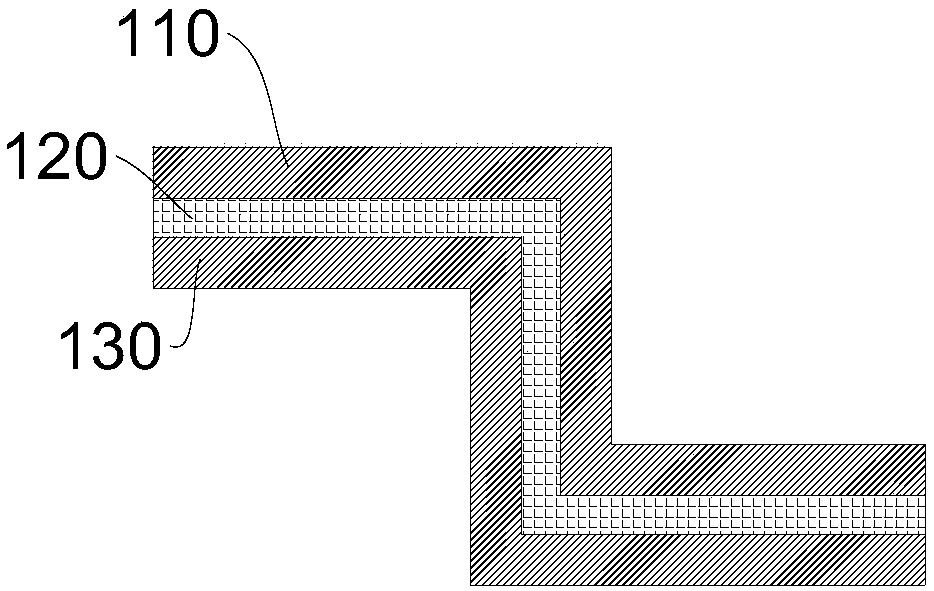Electric-heating film, preparation method and application thereof
An electric heating film and thin film technology, applied in the direction of electric heating devices, ohmic resistance heating, ohmic resistance heating parts, etc., can solve the problems of PET protective film peeling, resin aging, deformation that cannot be stretched or shrunk in three-dimensional curved surface dimensions, etc. Achieve good heating effect
- Summary
- Abstract
- Description
- Claims
- Application Information
AI Technical Summary
Problems solved by technology
Method used
Image
Examples
preparation example Construction
[0049] The preparation method of electrothermal film, comprises the steps:
[0050] (1) Forming a film on the surface of the base material with conductive ink to prepare the heating layer 120 . The heating layer 120 is formed by forming a film on the surface of the base material by using a conductive ink composed of a low-temperature softening resin and a conductive filler. The substrate is one or a combination of films, plates and fabrics. The substrate may also be the first protective layer 110 or the second protective layer 130 or other film-forming substrates.
[0051] Optionally, the heating layer 120 is formed by forming a film on the surface of the substrate at one time by using conductive ink. The film formation can be carried out by one or more of printing, coating and spraying, and the heat generating layer 120 is made by printing, coating and spraying conductive ink on the surface of the substrate.
[0052] (2) Coating metal paste on the surface of the heating la...
Embodiment 1
[0058] Conductive ink containing epoxy resin with a softening temperature of 70-100°C (for example: 70°C, 90°C or 100°C) is used as raw material, wherein the mass percentage of epoxy resin in non-volatile components is 40%. As the first protective layer 110 and the second protective layer 130 , a POFC film that undergoes abnormal deformation at a temperature of 70-100° C. (for example: 70° C., 90° C. or 100° C.) is used.
[0059] A cylindrical coating roller is used to coat the conductive ink on the POFC film, and the heating layer 120 is formed after drying. Metal paste is used to form bus bars on the surface of the heating layer 120, and the two sides of the heating layer 120 are hot-pressed and laminated with POFC film. After hot-pressing and compounding, the production of the electrothermal film product is completed. Wherein, the temperature of the thermocompression lamination is 60°C, and the pressure is 0.2Mpa.
[0060] The electrothermal film is wrapped on the surface ...
Embodiment 2
[0062] As the first protective layer 110 and the second protective layer 130 , PET films that undergo special-shaped deformation under the condition of 100-120° C. (for example: 100° C., 110° C. or 120° C.) are used.
[0063] A cylindrical coating roller is used to coat common conductive ink on the PET film, and the heating layer 120 is formed after drying. Metal paste is used to form bus bars on the surface of the heating layer 120, and the two sides of the heating layer 120 are cold-pressed and laminated with PET film. After cold-pressing and laminating, the production of the electrothermal film product is completed. Among them, the pressure of cold pressing is 0.8Mpa.
[0064] The electrothermal film is wrapped on the surface of the valve. It is observed that after the electrothermal film is heated, the shrinkage rate reaches 15%, and it is completely attached to the surface of the valve. The heating effect is good, but cracks, faults and peel off.
PUM
| Property | Measurement | Unit |
|---|---|---|
| Softening temperature | aaaaa | aaaaa |
| Softening temperature | aaaaa | aaaaa |
| Softening temperature | aaaaa | aaaaa |
Abstract
Description
Claims
Application Information
 Login to View More
Login to View More - R&D
- Intellectual Property
- Life Sciences
- Materials
- Tech Scout
- Unparalleled Data Quality
- Higher Quality Content
- 60% Fewer Hallucinations
Browse by: Latest US Patents, China's latest patents, Technical Efficacy Thesaurus, Application Domain, Technology Topic, Popular Technical Reports.
© 2025 PatSnap. All rights reserved.Legal|Privacy policy|Modern Slavery Act Transparency Statement|Sitemap|About US| Contact US: help@patsnap.com



